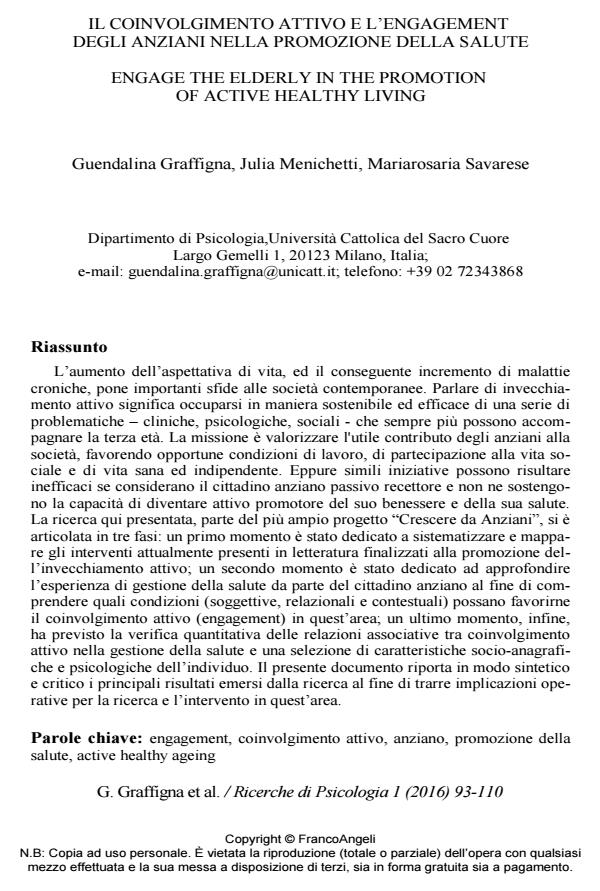Il coinvolgimento attivo e l’engagement degli anziani nella promozione della salute
Titolo Rivista RICERCHE DI PSICOLOGIA
Autori/Curatori Guendalina Graffigna, Julia Menichetti, Mariarosaria Savarese
Anno di pubblicazione 2016 Fascicolo 2016/1
Lingua Italiano Numero pagine 18 P. 93-110 Dimensione file 272 KB
DOI 10.3280/RIP2016-001007
Il DOI è il codice a barre della proprietà intellettuale: per saperne di più
clicca qui
Qui sotto puoi vedere in anteprima la prima pagina di questo articolo.
Se questo articolo ti interessa, lo puoi acquistare (e scaricare in formato pdf) seguendo le facili indicazioni per acquistare il download credit. Acquista Download Credits per scaricare questo Articolo in formato PDF

FrancoAngeli è membro della Publishers International Linking Association, Inc (PILA)associazione indipendente e non profit per facilitare (attraverso i servizi tecnologici implementati da CrossRef.org) l’accesso degli studiosi ai contenuti digitali nelle pubblicazioni professionali e scientifiche
L’aumento dell’aspettativa di vita, ed il conseguente incremento di malattie croniche, pone importanti sfide alle società contemporanee. Parlare di invecchiamento attivo significa occuparsi in maniera sostenibile ed efficace di una serie di problematiche – cliniche, psicologiche, sociali - che sempre più possono accompagnare la terza età. La missione è valorizzare l'utile contributo degli anziani alla società, favorendo opportune condizioni di lavoro, di partecipazione alla vita sociale e di vita sana ed indipendente. Eppure simili iniziative possono risultare inefficaci se considerano il cittadino anziano passivo recettore e non ne sostengono la capacità di diventare attivo promotore del suo benessere e della sua salute. La ricerca qui presentata, parte del più ampio progetto "Crescere da Anziani", si è articolata in tre fasi: un primo momento è stato dedicato a sistematizzare e mappare gli interventi attualmente presenti in letteratura finalizzati alla promozione dell’invecchiamento attivo; un secondo momento è stato dedicato ad approfondire l’esperienza di gestione della salute da parte del cittadino anziano al fine di comprendere quali condizioni (soggettive, relazionali e contestuali) possano favorirne il coinvolgimento attivo (engagement) in quest’area; un ultimo momento, infine, ha previsto la verifica quantitativa delle relazioni associative tra coinvolgimento attivo nella gestione della salute e una selezione di caratteristiche socio-anagrafiche e psicologiche dell’individuo. Il presente documento riporta in modo sintetico e critico i principali risultati emersi dalla ricerca al fine di trarre implicazioni operative per la ricerca e l’intervento in quest’area.
Parole chiave:Engagement, coinvolgimento attivo, anziano, promozione della salute, active healthy ageing
- Senior Housing: Typological Innovation via Mixed Use Architecture for Social Integration and Wellness in Italy Daniela Ladiana, Flavia Iaccarino, in Journal of Civil Engineering and Architecture /2025 pp.461
DOI: 10.17265/1934-7359/2025.10.001
Guendalina Graffigna, Julia Menichetti, Mariarosaria Savarese, Il coinvolgimento attivo e l’engagement degli anziani nella promozione della salute in "RICERCHE DI PSICOLOGIA " 1/2016, pp 93-110, DOI: 10.3280/RIP2016-001007